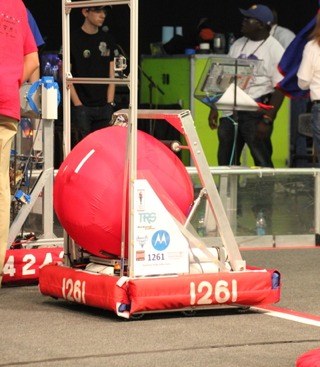Log in if you already have an account. If you would like to become an editor for the wiki, request an account.
Difference between revisions of "Genesis"
| Line 31: | Line 31: | ||
The team won the Palmetto regional with, as well as winning the Industrial Design award at the Peachtree Regional. | The team won the Palmetto regional with, as well as winning the Industrial Design award at the Peachtree Regional. | ||
| + | |||
| + | {{FRCRobotBar}} | ||
[[Category: Robots]] | [[Category: Robots]] | ||
Revision as of 17:16, 30 December 2015
| Genesis | |
|---|---|

| |
| Robot | Genesis |
| Year | 2014 |
| Competition | |
About Genesis
Genesis was built for the 2014 FRC game Aerial Assist and its name was used to signify a new beginning.
Drive Train
Genesis' drive train was the Kit of Parts drive train from 2014 in a square configuration (AndyMark AM14U). This robot used 6 4 inch traction wheels (from the KOP), with dropped center wheels. The gearboxes were toughbox minis with CIM motors, and all 6 wheels were driven using Gates belting.
Manipulator
Genesis' manipulator consisted of two parts, the intake and the shooter. The intake was a metal rectangle that moved into and out of the robot with the use of two pneumatic cylinders (one on each side). At the top of the rectangle was a spinning axle with a rubber covering that would grab the ball and pull it into the robot. Once inside, it landed on the shooter, a catapult-like design that launched the ball into the air using two more pneumatic cylinders. By Worlds, the robot had a total of 9 air tanks on it, so it would never be too long between shots. This robot made use of two photogates. The first to help sense when the ball was inside the manipulator arm, and the second to help sense once the ball was fully inside the robot. These helped to control the intake (as soon as the ball was captured by the roller, the pneumatics would begin pulling it up into the robot).
Autonomous
Genesis had several different autonomous programs, which was one of the reasons the team was able to be so successful in 2014. It had a 1 ball auto where it would pick up the ball and shoot it into one of the high goals, but it also had a 2 ball auto, where one ball started inside the robot, and the other in front of it. It would launch the first, then the second into the high goal, scoring between 30 and 40 points (depending on which goal was hot).
Programming
Genesis was the first of the team's robots to be programmed in Java. 2014 was the year the team made the switch from LabView
Awards
The team won the Palmetto regional with, as well as winning the Industrial Design award at the Peachtree Regional.
| FRC Robot Navigation | |||||||||
|---|---|---|---|---|---|---|---|---|---|
| 2016 | 2015 | 2014 | 2010 | 2009 | 2008 | 2007 | 2006 | 2005 | 2004 |
| Khanquistador | Alvin | Genesis | Chimichanga - Logan Chassis | Logan Rover - Clean Sweep | Longshot | Thunderhorse - Nimble Gimbal | Swervin' Mervin' | Capek | Unnamed Robot |